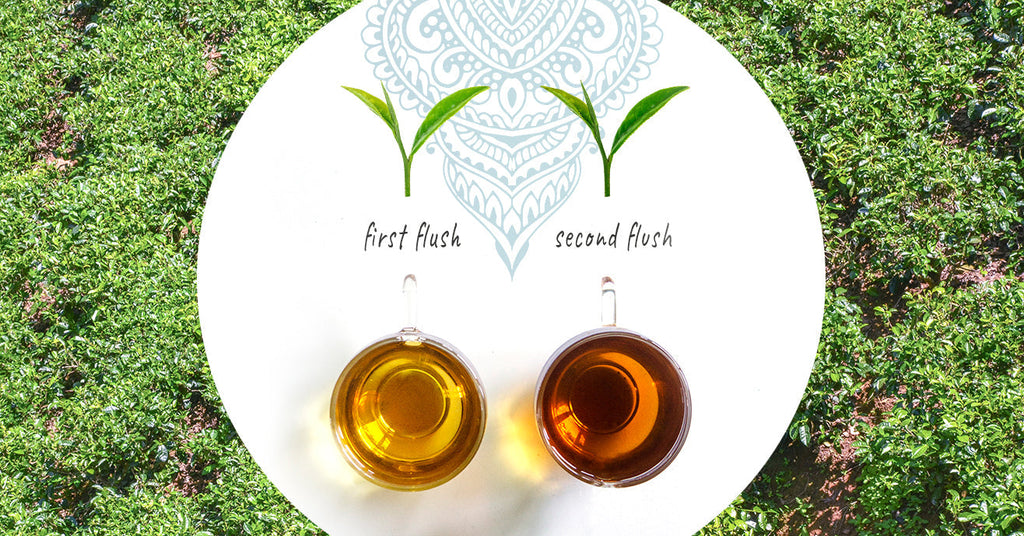First Flush Vs. Second Flush Tea

Have you ever looked at different teas and wondered what a first flush tea is? And for that matter, what is second flush tea? We get this a lot, as well as the question that most commonly follows: well, which is better, first flush or second flush?
While origins around the world use the terms first and second flush to refer to different harvest windows, most of the time, people are referring to teas from Darjeeling. Specifically, to lighter black teas that have made Darjeeling the world’s most iconic tea origin. Though there are similarities, devout tea drinkers can appreciate many differences, and I think that exploring these two side by side is exemplary of how interesting and delightful the field of tea is!
How They’re Similar
First and second flush teas primarily refer to teas specifically from the tea region of Darjeeling (though any tea picked in the first or second harvest windows can be labeled as such). Since they are from Darjeeling, the terroir is the same, meaning the tea is grown in the same soils, same rainfall patterns and same sunlight exposure. Additionally, if the first and second flush you are trying are from the same tea estate, then the very same plants will be used to make both teas, just harvested at different times of the year. Finally, both the first and second flush harvests are oxidized, and according to most definitions, both are black teas. However due to the very short oxidizing window that first flush gets, it often resembles a light roasted oolong more than a malty Assam black.
How They’re Different
The main difference between first and second flush are the harvest windows. First flush is the first harvest window of the year, typically late February to late April. The second harvest that is turned into second flush runs early May to the middle of June. Between the first and second flushes, the plants undergo a “bhanji period,” when the tea plants rest and stop putting out new growth. While it’s never set in stone (we’re dealing with Mother Nature, after all), the bhanji lasts about 2-3 weeks in between flushes.
The two teas are also processed differently, specifically with how long the rolled leaf is oxidized. For first flush, it’s a lightning fast process - sometimes less than 15 minutes - versus a standard 2-3 hour oxidizing process for second flush. During the first flush season, tea makers are working around the clock. It is quite something to see literally tons of fresh leaf zip through the processing floor, because to stop oxidizing, the tea makers need to quickly get the leaf into the dryer, or it will continue to oxidize.
Of course, the thing tea drinkers notice about first flush versus second flush is the flavor. First flush is explosively aromatic, but makes a very light cup in flavor and color. Second flush shows up with a deeper body, a dark amber hue and less fragrant as its predecessor. You can expect the second flush to be full-bodied with Darjeeling's signature notes of “muscat grape.”
Which Tea Is Better, First Flush Or Second Flush?
This is of course an individual decision, but the popular opinion has changed over time. According to old timers in the tea industry, it was originally the second flush teas that put Darjeeling on the map. The Germans started buying it in a big way during the 70s, which jump-started the demand. However, in the last 20 years or so, there’s been a shift towards first flush.
Personally, I’m in this latter camp, and sometimes get grief from some more experienced tea drinkers, who think the first flush is an “unworked” leaf with little of the backbone that makes a truly great tea. That being said, early season teas are known to have a higher caffeine content since the plant is producing the caffeine as a defense for their first delicate buds of spring. As a fervent caffeine consumer, I am almost always happy to trade depth for a lighter, aromatic cup that truly makes me float!
We'd love to know...which one do you prefer? Leave us a comment below.
Want To Experience The Differences And Similarities Yourself? Try:
You might also enjoy:
- The Evolution Of Darjeeling Tea
- How Black Tea Is Made
- Other Darjeeling Teas
Blog Author:

Raj Vable, Founder
He has been confounded by the leaf since his first transcendental encounter with white tea in 2010. Three years later, he started Young Mountain Tea to bridge his budding tea obsession with his interest in traveling in the mountains and previous experience creating job opportunities in rural India. He revels in working across cultures and can be regularly found trying to get the rest of the team on board with another outlandish tea project. His favorite teas remain white, and he’s always searching for the next cup of magic.




Comments on this post (1)
Like Raj (pleasantly informative blog by the way), I prefer first flush, something exotic in the aroma and flavor profile that thrills me.
— Tom Howard